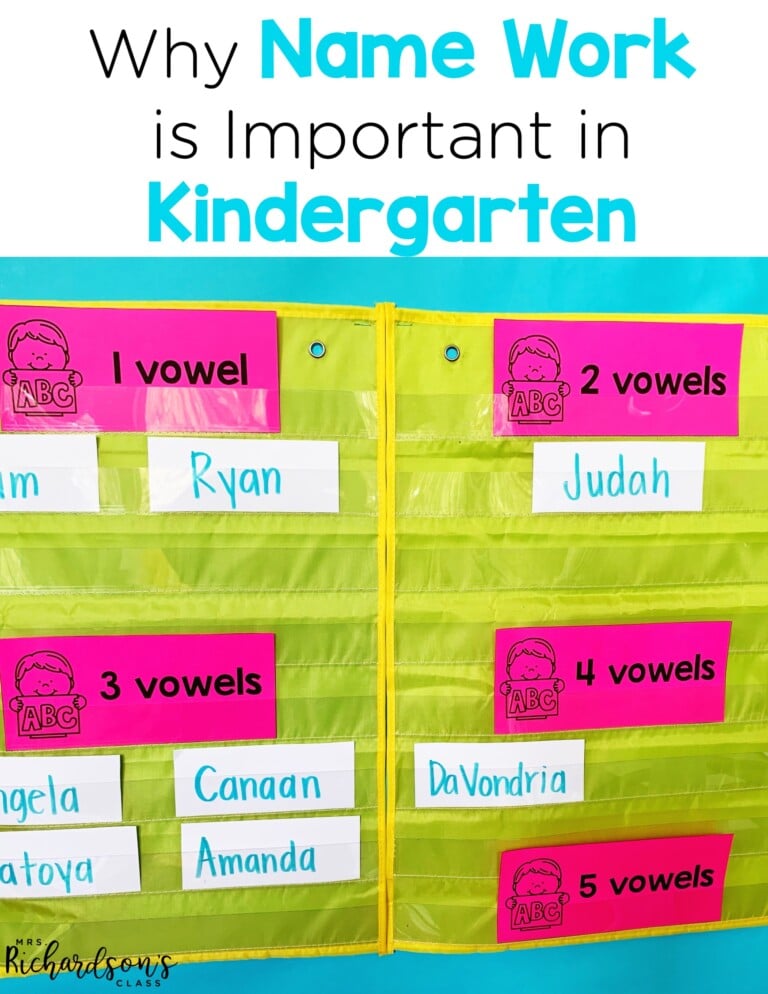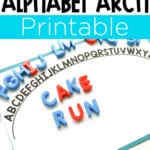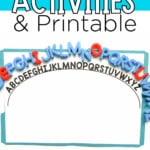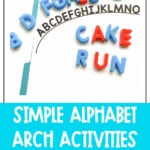


Alphabet arcs…you’ve probably seen them if you are a primary teacher. But do you know how to use them? Do you know why so many people think they are a valuable tool? I remember during my first year of teaching, a had a small group set of alphabet arcs. But I really didn’t know how to use them! I had my students touch and say their letters and match letters, but I definitely didn’t feel like I knew what I was doing.
Is that you? Then you’re in the right place! Or maybe you have a general idea of what to do with alphabet arcs, but you want some more activities to try. You’re also in the right place! Today we’re diving into alphabet arcs, why they’re an important literacy tool, and how to use them.
An alphabet arc is a visual and kinesthetic representation of the alphabet in a curved line or arc shape. It typically consists of large letters placed in sequence along a path that students can trace with their fingers or place objects upon. Some arcs will have consonants in blue and vowels in red.
Alphabet arcs may have all of the letters or just the anchoring letters, A, M, N, and Z. The letters can up uppercase or lowercase.
Alphabet arcs make powerful literacy tools for pre-readers and early readers. First, the support alphabetic knowledge. Alphabetic knowledge is simply knowledge of the alphabet. It is the ability of the student to instantly recognize the letters of the alphabet, name the letters, alphabet order and structure, know what each letter’s shape is, and know and say the sounds each letter represents. These skills are so important and oftentimes we assume students come to us already knowing them.
They also provide multi-sensory learning. Students use multiple senses (touch and sight) while they interact with an arc. The tactile experience helps both kinesthetic and visual learners and reinforces letter recognition and the connection between letters and sounds.
Additionally, alphabet arcs can help with letter formation as students can trace the different letters of the alphabet in both lowercase and uppercase.
Finally, alphabetic arcs can help students understand the alphabet’s sequencing and order. The arc’s layout reinforces the sequence of the alphabet, supporting our young readers in developing a strong sense of alphabetical order.
These are some of my favorite alphabet arc activities. You can do them 1-1, in reading small groups, or even in a whole group setting. If you don’t know your students’ level of alphabetic knowledge yet, I recommend starting with the most support. That means a full alphabet arc with all of the letters in either uppercase or lowercase.
As your students begin to master the order of the alphabet and increase their alphabetic knowledge, you might want to switch to an arc with just the anchor letters or A and Z.
For pre-readers, one skill students can practice is letter sorting. It can be as basic as finding a group of letters and sorting them by shape. For example, tall or short letters and sorting letters with sticks or curves.
You can have students match magnetic letters, letter tiles, foam letters, or any other manipulative to the letters on the alphabet arc. You could also do uppercase and lowercase matching by using manipulatives in the opposite case as your arc.
One way to practice sequencing is to have students match a set of letters to the alphabet arc. To increase difficulty, you can have students name the letter they have and the letters that come before and after it. You can also switch to an alphabet arc with just anchor letters( A, M, N, Z) for increased difficulty. You can give students a set of letters that would all be in order or skip letters in between them for a challenge.
You could have students hunt for letters in several different ways. First, you can simple call out a letter and have students find it. Another idea is to say something like “I’m looking for the letter that makes this sound __.” and have students find the correct letter.
For more of an independent activity, students can get a group of random letters. Then, they can say the letter and its sound and set it on the alphabet arc.
My students always loved this activity! Show students a set of letters (I always started with the letters in order for my struggling students) but have one letter missing. Ask students to see if they can figure out what letter is missing. They can hunt for the missing letter and add it in the sequence of letters.
To increase difficulty, show students the set of letters but out of order. Have students put the letters in order and then figure out which letter is missing.
When students are ready, you can have them begin to build words with alphabet arcs. I liked to start with short vowel CVC words. Start by saying a word, and then have students repeat it. I asked them to count how many sounds they heard so they know how many letters they’ll need. Then, have students build the word, saying each sound as they grab a letter.
If you think your students would benefit from some of these alphabet arc activities, I have a FREE alphabet arc for you! I put together a set of printable literacy manipulatives so you and your students can have some awesome things right at your fingertips. Just enter your email below and I’ll send them right to you!
I hope you can see why I love an alphabet arc in the primary classroom! Its multi-sensory approach, combined with interactive activities, helps kindergarteners and first grade students build a strong foundation in language skills. By incorporating these fun and engaging activities into your classroom, you can help students develop a strong foundation in reading.
pin it

Want to use the latest research to boost your readers during small groups? This FREE guide is packed with engaging ideas to help them grow!

I’m a K-1 teacher who is passionate about making lessons your students love and that are easy to implement for teachers. Helping teachers like you navigate their way through their literacy block brings me great joy. I am a lifelong learner who loves staying on top of current literacy learning and practices. Here, you’ll find the tools you need to move your K-2 students forward!


| Cookie | Duration | Description |
|---|---|---|
| cookielawinfo-checkbox-analytics | 11 months | This cookie is set by GDPR Cookie Consent plugin. The cookie is used to store the user consent for the cookies in the category "Analytics". |
| cookielawinfo-checkbox-functional | 11 months | The cookie is set by GDPR cookie consent to record the user consent for the cookies in the category "Functional". |
| cookielawinfo-checkbox-necessary | 11 months | This cookie is set by GDPR Cookie Consent plugin. The cookies is used to store the user consent for the cookies in the category "Necessary". |
| cookielawinfo-checkbox-others | 11 months | This cookie is set by GDPR Cookie Consent plugin. The cookie is used to store the user consent for the cookies in the category "Other. |
| cookielawinfo-checkbox-performance | 11 months | This cookie is set by GDPR Cookie Consent plugin. The cookie is used to store the user consent for the cookies in the category "Performance". |
| viewed_cookie_policy | 11 months | The cookie is set by the GDPR Cookie Consent plugin and is used to store whether or not user has consented to the use of cookies. It does not store any personal data. |



4 Responses
I put magnets on the back of the arc and put on a cookie sheet… magnetic letters stick and don’t get lost!
Cindy, I LOVE that idea!! That’s perfect!!
I was wondering if you have the Alphabet Arc in lowercase letter format. If so, could you possibly send it to my e-mail address.
Thank you!
Hi! I only have it in upper case at this time. I’m sorry!